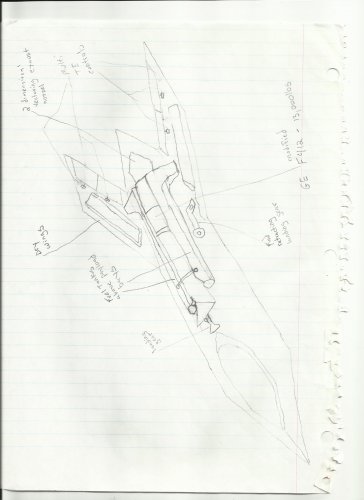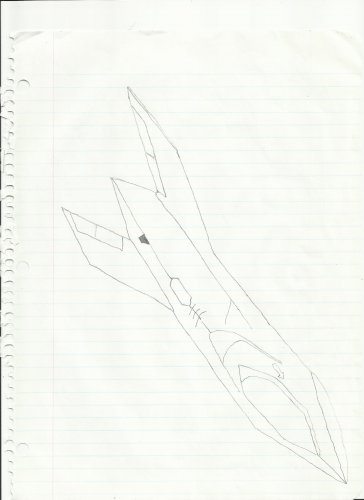You are using an out of date browser. It may not display this or other websites correctly.
You should upgrade or use an alternative browser.
You should upgrade or use an alternative browser.
How good would a full scale Boeing Bird of Prey be?
- Thread starter malipa
- Start date
XP67_Moonbat
ACCESS: Top Secret
- Joined
- 16 January 2008
- Messages
- 2,271
- Reaction score
- 544
None of the above. The BOP was just a technology demonstrator and it's not clear that Boeing was looking at a production variant. The BOP was a very bare-bones plane without any sort of frills including a weapons bay.
But you did see certain design elements pop up like in the X-45 UCAV demonstrator.
From a purely hypothetical viewpoint though, I honestly feel if if had been scaled up into full-size production variant, Boeing would probably just have stuck to guns and missiles. Remember, about 12 years ago, lasers and microwave weapons were also talked about, in hypothetical terms, for the F-35 at that point in its development.
But at the end of the day, we're still seeing the tried and true formula in use.
But you did see certain design elements pop up like in the X-45 UCAV demonstrator.
From a purely hypothetical viewpoint though, I honestly feel if if had been scaled up into full-size production variant, Boeing would probably just have stuck to guns and missiles. Remember, about 12 years ago, lasers and microwave weapons were also talked about, in hypothetical terms, for the F-35 at that point in its development.
But at the end of the day, we're still seeing the tried and true formula in use.
- Joined
- 2 August 2006
- Messages
- 3,255
- Reaction score
- 1,527
Scaled up, I could see it being used in the role previously performed by the F-117. But I can't really see it being used as a true fighter as it just doesn't seem it would have the control power required for high alpha flight or enough wing area for any reasonable sustained turn rate.
TAGBOARD
ACCESS: Restricted
- Joined
- 10 December 2010
- Messages
- 36
- Reaction score
- 1
Agreed with all posts.
In addition, the aircraft was statically stable in pitch and yaw, but likely not roll. What this means it's like a general aviation pushrod/pulley setup you might see on a Cirrus SR-22. You can see the aft vertical stabilizer added in the form of a ventral fin in some images in flight, as evidence. I recall flight test reports from the pilot stating the aircraft was difficult to control in parts of the flight envelope. There's no canard or horizontal stabilizer, so you'll not trim more than an overall lift coefficient of around 0.6. This makes the aircraft bad for agility as required for a fighter (read high load factors). Also, look at the planform. There's very little overall aspect ratio. This is why the Northrop X-47 variants have the long slender wing panels protruding from the diamond-shaped bodies. If you don't have aspect ratio, you don't have glide ratio and thus poor endurance.
With an autopilot:
The lack of an autopilot makes it bad for transonic speeds (speed as a form of survivability for attack) where the aerodynamic center moves aft. You'll also have difficulty trimming in pitch due to the shovel nose shape that most low observable designers start with before learning they're bad for pitch. All of this points to the need for an autopilot, built on a nicely arranged 6-DoF aerodynamic database, based a wind tunnel test and good flight simulation work - which is within the art of the possible. The low lift planform is not necessarily bad for an attack role such as the GD A-12 planned. I think this is likely the path McDonnell took if it lived on in another life. Their challenges would sit in increasing airflow to, and the efficiency of, the inlet. Probably involved a move to make the inlet look more like the GlobalFlyer as an example - more conventional and less buried. They'd also need more aspect ratio, so you'd see more slender wing panels protrude and more overall size, in the form of a photographically scaled planform (read larger).
Without an autopilot:
I think McDonnell got away with this one aerodynamically for low speeds (i.e. less the 200 keas). But they'd likely not venture into other roles due to some of the reasons I mentioned above: Too slow for attack and jets, too weak in pitch for fighting. If you're limited to low Mach numbers, why use a turbofan? For low observability? OK, but you'll pay the penalty in endurance simply because turbofan engines like higher subsonic mach numbers. Just look at RQ-3A as an example, the endurance sits around 8 hours. Pretty low for an unmanned vehicle that needs to sit aloft for as long as possible. One remaining role that it could fulfill (poorly) would be manned ISR. You could get away with a steady weight payload (ISR gear), to not confuse the aircraft in pitch upon store release. Problem is the endurance is bad, due to slow speeds (turbine engine with an inefficient inlet). Perfect for a pilot - who has limited physiological endurance - as we read about in the AQUATONE project in one of Curtis Peebles books.
All this to say, it may have become a low endurance manned ISR platform or transonic unmanned attack platform.
In addition, the aircraft was statically stable in pitch and yaw, but likely not roll. What this means it's like a general aviation pushrod/pulley setup you might see on a Cirrus SR-22. You can see the aft vertical stabilizer added in the form of a ventral fin in some images in flight, as evidence. I recall flight test reports from the pilot stating the aircraft was difficult to control in parts of the flight envelope. There's no canard or horizontal stabilizer, so you'll not trim more than an overall lift coefficient of around 0.6. This makes the aircraft bad for agility as required for a fighter (read high load factors). Also, look at the planform. There's very little overall aspect ratio. This is why the Northrop X-47 variants have the long slender wing panels protruding from the diamond-shaped bodies. If you don't have aspect ratio, you don't have glide ratio and thus poor endurance.
With an autopilot:
The lack of an autopilot makes it bad for transonic speeds (speed as a form of survivability for attack) where the aerodynamic center moves aft. You'll also have difficulty trimming in pitch due to the shovel nose shape that most low observable designers start with before learning they're bad for pitch. All of this points to the need for an autopilot, built on a nicely arranged 6-DoF aerodynamic database, based a wind tunnel test and good flight simulation work - which is within the art of the possible. The low lift planform is not necessarily bad for an attack role such as the GD A-12 planned. I think this is likely the path McDonnell took if it lived on in another life. Their challenges would sit in increasing airflow to, and the efficiency of, the inlet. Probably involved a move to make the inlet look more like the GlobalFlyer as an example - more conventional and less buried. They'd also need more aspect ratio, so you'd see more slender wing panels protrude and more overall size, in the form of a photographically scaled planform (read larger).
Without an autopilot:
I think McDonnell got away with this one aerodynamically for low speeds (i.e. less the 200 keas). But they'd likely not venture into other roles due to some of the reasons I mentioned above: Too slow for attack and jets, too weak in pitch for fighting. If you're limited to low Mach numbers, why use a turbofan? For low observability? OK, but you'll pay the penalty in endurance simply because turbofan engines like higher subsonic mach numbers. Just look at RQ-3A as an example, the endurance sits around 8 hours. Pretty low for an unmanned vehicle that needs to sit aloft for as long as possible. One remaining role that it could fulfill (poorly) would be manned ISR. You could get away with a steady weight payload (ISR gear), to not confuse the aircraft in pitch upon store release. Problem is the endurance is bad, due to slow speeds (turbine engine with an inefficient inlet). Perfect for a pilot - who has limited physiological endurance - as we read about in the AQUATONE project in one of Curtis Peebles books.
All this to say, it may have become a low endurance manned ISR platform or transonic unmanned attack platform.
Matej
Multiuniversal creator
Why we expect that in its realworld form it was not in a full scale? This demonstrator had only one real purpose - to show USAF that hey, we, McAir are also capable of producing great stealth airplanes in the same way Lockheed and Northrop are able to.
Have Blue was scaled - down demonstrator for a stealth technology combat plane, even Tacit Blue was designed in the way, that in the future it could serve as a SLAR radar platform, but I am not aware of any at least theoretical plans to turn Bird of Prey into something serial produced.
Have Blue was scaled - down demonstrator for a stealth technology combat plane, even Tacit Blue was designed in the way, that in the future it could serve as a SLAR radar platform, but I am not aware of any at least theoretical plans to turn Bird of Prey into something serial produced.
The bird of prey was designed to demonstrate certain stealth technology. period. as such it probably wasn't designed to be good for anything else. so why would it be good for anything else? Scaled up bird of prey would probably be good only for wasting more money to redundantly demonstrate, expensively, what the original bird of prey has already done more cheaply.
- Joined
- 4 May 2008
- Messages
- 2,439
- Reaction score
- 762
In order to use EMP you need to solve the issue of committing electronic suicide first. It's difficult to shield your own systems from 'leakage' of your EM blast. Not impossible, but most likely beyond the current state-of-the-art.
AeroFranz said:In order to use EMP you need to solve the issue of committing electronic suicide first. It's difficult to shield your own systems from 'leakage' of your EM blast. Not impossible, but most likely beyond the current state-of-the-art.
You can have two independent electrical/electronic systems. One for the EMP, the other capable of being completely, mechanically sealled off in a faraday cage.
F-24A Stats: Program start Oct 1999
Max weight 39,892lbs
Engine: modified GE F412-400= 13,000lbs thrust canceled A-12 engine
Fuel: 7,830lbs
Payload: 5,000lbs max: 2 2000lbs JDAM or Laser guided 2 AIM-120c
Empty Airframe weight: 24,000lbs
Radar: Raytheon AESA pre-APG-79 radar
EO system: Modified An/AAS-44c Multi Spectral Targeting System
Max weight 39,892lbs
Engine: modified GE F412-400= 13,000lbs thrust canceled A-12 engine
Fuel: 7,830lbs
Payload: 5,000lbs max: 2 2000lbs JDAM or Laser guided 2 AIM-120c
Empty Airframe weight: 24,000lbs
Radar: Raytheon AESA pre-APG-79 radar
EO system: Modified An/AAS-44c Multi Spectral Targeting System
Wouldn't EMP be of limited military value? Tanks, fighters, etc have emp protection. Would it be used on unprotected civilian targets as a "bomber"? I would think a railgun or some type of beam weapon would be better for defense against aircraft, missiles and ground targets.
- Joined
- 4 May 2008
- Messages
- 2,439
- Reaction score
- 762
EMP would be a great SEAD weapon. Radars have very sensitive apertures designed to pick up the slightest signal. A powerful EMP pulse would be the equivalent of pointing a bullhorn at someone wearing a hearing aid device. It would be...unsettling to say the least.
Contract: The advantages of super low observables and reduced visual signature once demonstrated by the Boeings Bird of Prey Technology demonstrator quickly led to a sole source development contract. It called for five full-scale development and fifteen production models of a single-seat, subsonic daylight attack aircraft to be officially designated F-24A. The aircraft is the airforces silver bullet strike force.
- Joined
- 6 August 2007
- Messages
- 3,894
- Reaction score
- 5,978
malipa said:Could it carry weapons?
Could it carry a EMP weapon instead of a gun?
The Boeing Bird of Prey was a technology demonstrator. It was used to test new manufacturing techniques and advanced low observables technologies. It was never intended to lead to an operational aircraft. The aircraft's performance and handling would not have made a very good operational aircraft! DLR has a great article on the program by Peter Merlin.
Bird of Prey's legacy lives on in other programs including the X-45, X-32, and others.
AeroFranz said:In order to use EMP you need to solve the issue of committing electronic suicide first. It's difficult to shield your own systems from 'leakage' of your EM blast. Not impossible, but most likely beyond the current state-of-the-art.
There are two threats: High altitude electromagnetic pulse and high powered microwave. HEMP is produced by the detonation of an atomic device in the upper atmosphere. HPM can be produced with a small device, does not require an atomic bomb, and the effects are more easily tailored or focused. This and other factors make HPM devices more attractive as weapons.
Many systems are hardened against EMP, but hardening against HPM has different requirements even if the effects appear similar. A system protected against EMP is not necessarily protected against HPM.
The Congressional Research Service document "High Altitude Electromagnetic Pulse (HEMP) and High Power Microwave (HPM) Devices: Threat Assessments" is a good starting point for this subject.
http://www.dtic.mil/cgi-bin/GetTRDoc?AD=ADA480808
Similar threads
-
-
-
My F-118A Silent Bird speculative design
- Started by Empire
- Replies: 4
-
-
Northrop X-47A once a manned design
- Started by Empire
- Replies: 21



